Collectively, Korean archery is as strong as it has ever been. The recurve standard creeps higher every year, the compound team is now undoubtedly amongst the world’s elite, and the medals keep coming, despite a few wobbles in 2019. But why? In this post, originally a series of articles published in 2018, and now fully updated, Bow investigates.
All pics by Dean Alberga except where noted.

THE SYSTEM
Back in August 2001, shortly before the World Championships in Beijing, the Korean men’s first team apparently refused to participate in a ‘fear training’ exercise held underwater. This was one of an unconfirmed series of headline-grabbing exercises claimed to have been foisted on the national team archers over the years, including snake handling and bungee jumping. The Korea Archery Association issued a penalty order on all four of them, removing them from the national side, and sent their ‘B team’ to Beijing instead. The result? The B team, featuring future Olympic gold medallists Park Kyung-mo and Lee Chang-hwan, swept the podiums anyway.
The incident was widely reported in the Korean media. Whether the additional training (or the penalty) was justified or not, the base was already so strong and deep that the decision was easy. In other sports, star players are more powerful, and governing bodies often have the problem that it would weaken the team’s strength to give a penalty to the star athletes for any dissent or refusal. Thus, the deep base of athletes gives more power to the structure underlying it.
Former athlete Lee Eun-Kyung, a gold medallist at the Barcelona Games in 1992, explained a great deal about the behind-the-scenes structure to Korean news agency Naver in a lengthy article in 2017, which has never been translated into English until now. When asked a standard question why Korea produces the world’s best archers, she replied: “It is difficult to explain one specific reason why [we] are so good. However, if you had to it would be ‘the system’. There are basic principles, rationality, and transparency within that system.”
What is this system? Faith in a system to produce results isn’t characteristic of all sports, and certainly not classic sports narratives. But Korea never relies on a single archer or a single coach to win. It places faith in structures: of talent recognition, coaching, a school, the university and professional system, open trials, and finally an elite-of-the-elite international programme to get the job done. Perhaps unsurprisingly, it bears a slight resemblance to the operation of the chaebols, the paternalistic, family-owned mega-corporations like Samsung and LG that wield immense power in the country.
The complete operations manual of the national team is over 700 pages thick, and details every aspect of day-to-day training, including everything up to and including the schedule of the first day of a new athlete arriving at the national training centre. It shows a vital cog of the machine: daily, monthly, and annual training journals. There are examples of how to make journals, how to write them, and how to check them, as well as entire schedules for major competitions and tournament preparation methods.
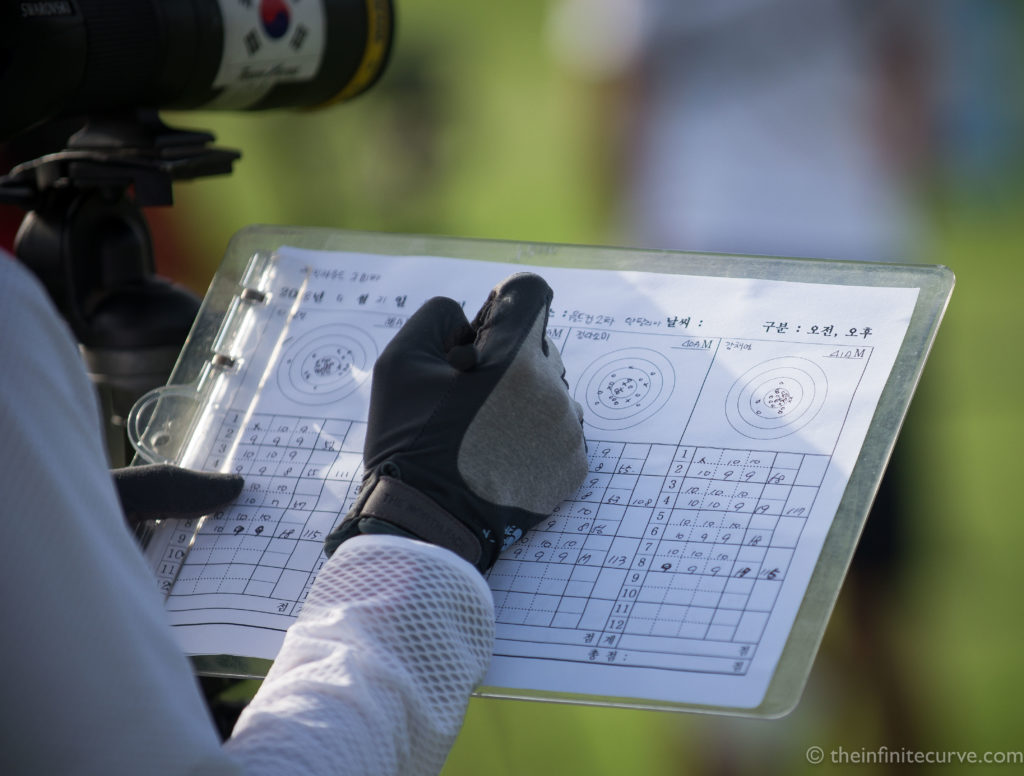
Ranking round arrows plotted by a Korean coach, Antalya 2018
There is another effect of this manual: no matter who is in charge at any one time, if one knows the formulas, it is believed that you can minimise trial and error and consistently achieve above basic performance. The senior coaches for the national teams change frequently; most are on a two year contract leading up to either an Olympics or an Asian Games; after that, the merry-go-round begins again. This system allows new coaches and new ideas to rotate in and out within the standardised coaching methods, and stops things getting stale. Having over 200 qualified coaches in Korea mean that there is tough competition for the top jobs; and even former athlete legends like Oh Kyo Moon, who coached the men’s team for the Asian Games in 2018, had to go through multiple successful appointments at home and abroad to get there.
Notably, there is direct communication with athlete’s professional teams. This includes what kind of training the athlete who has been selected as a national representative performs, every day. They share details of the condition of the athletes, and the food they ate in detail – everything. The primary reason for this is that the salaries of the players training in the national team are paid by the professional teams, so it is a basic principle to share all of the training data (as commonly happens in professional soccer).
A key job of senior coaches is to write detailed reports when they go to competitions and tournaments. There are also matrices about the match records of the players with attached arrow locations, and an analysis of opponents to see how many points they can win against a particular team. Nothing is left unexamined. These reports have accumulated for decades, and, along with the endlessly revised manual, are considered the ‘blueprint’ for how to prepare for any Olympic Games.
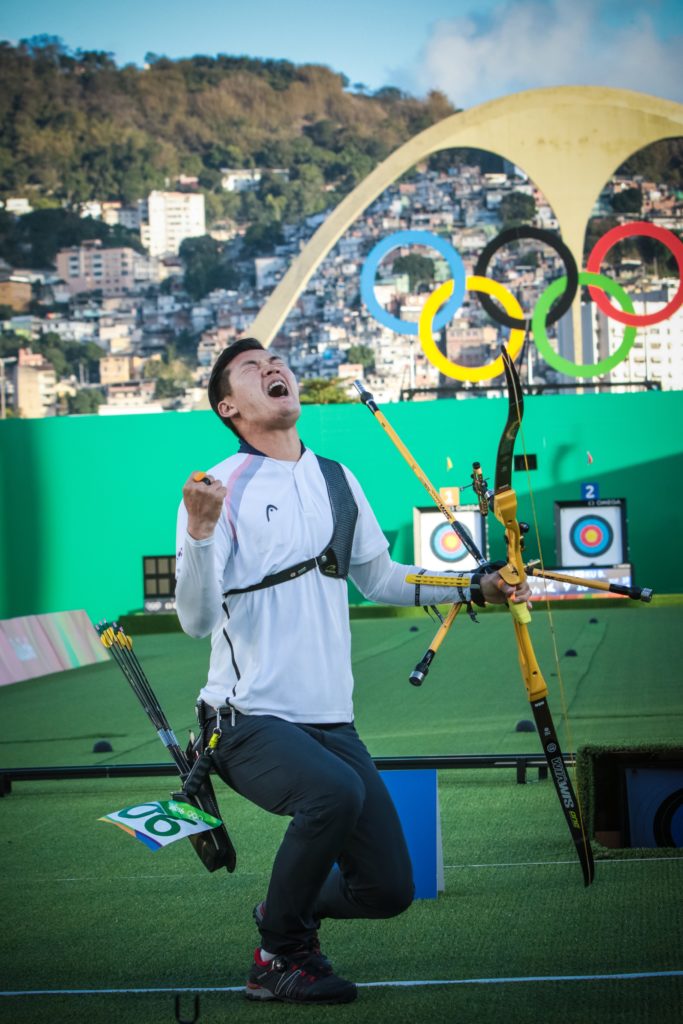
The meticulous nature of the preparation for an Olympics has resulted in some extraordinary public displays. For three Olympic cycles now, the KAA has sent teams to practice in a full baseball stadium in order that they can get used to the noise of stadium-sized crowds; although the photographs of the last event suggest it is now as much a publicity stunt as a serious training exercise. More extreme measures include studying London rain and wind patterns and scouring the country for a similar training location to get them used to British weather in 2012. Notoriously, the KAA built a near-complete replica of the Beijing archery stadium for the athletes to train in prior to the Games of 2008.
But all this bluster only exists for the big Games events. Indeed, the entire Korean archery system exists because it consistently wins Olympic and Asian Games medals for the nation. If it didn’t – or it stopped – things might change very fast.
It is not true that every Korean schoolchild gets to try archery; it’s a small subset, and just five primary schools are part of the programme in Seoul. Nevertheless, champion archers invariably start young. The best are then pushed through an increasingly narrow funnel of middle-school and high-school coaching programmes, to university and professional teams, and finally, a tiny fraction that get to represent their country internationally. There’s a big incentive at high school level: full sports scholarships to universities are available to the most promising archers. At each stage, athletes are left behind – they have to stop training and competing. Similarly, almost no archers continue to shoot after their professional career is over. There is (almost) nowhere to do so.

The tiny compound programme, at first with its ranks filled with older, second-tier professional recurve archers, was only expanded after the introduction of compound archery to the Asian Games in 2014. The compound team is an entirely separate entity from the recurve squad and trains separately from them at the national centre at Jincheon. Indeed, at international events, each team of four: men, women, recurve and compound eats and works apparently completely apart from each other, reminding observers of military units in the field.
Despite a long and interesting history of archery in the region, it is easy to characterise the wider Korean system as nothing but a brute-force approach to obtaining international event medals. Eun-Kyung is dismissive of such barbs, and points to the egalitarian approach that allows no superstars, and theoretically, anyone to make it to the top: “The archery players are proud that they have overcome the tough trials and are proud of receiving the best support. This pride is one of the most important forces that make Korean archery so strong. We do not make ‘bow shooting machines’ by squeezing players and pushing them to the limit. [The system] gives pride in each one of them, fairly competing and acknowledging their achievements. The reason why Korean archery cannot be easily imitated in other countries, or other sports, is the pride that comes from the long list of achievements.”
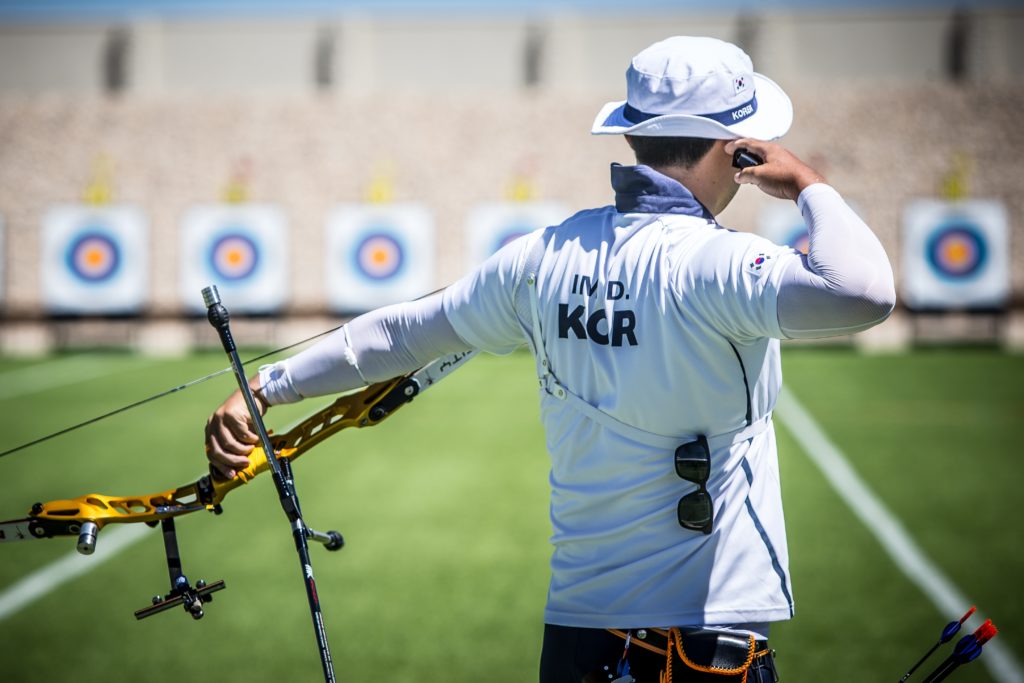
GETTING TO THE TOP
There are no shortage of ‘Why South Korean archers are the best in the world’ articles and videos online, which tend to focus on the well-known tropes: the many kids trying it, a standardised system of coaching, and the organised structure that funnels talented archers towards the top.
A few of the better ones note the absolute adherence to correct form which is insisted upon from the very first lesson. Korean schoolchildren do not even pick up a bow for months after starting formal archery training; it’s all done with a stretch band, teaching form and nothing else. In almost every other country in the world, archers start recreationally, becoming serious later, when it is much more difficult to remove bad habits. (When I mentioned this to a friend of mine who runs an archery business, a good part of which is have-a-gos and beginners courses, he said to me, laughing: “I’d like to see the reaction from that group of parents and kids when I told them they couldn’t touch a bow for six weeks.”)
It should also be noted that there are also different social and cultural dynamics in place in the region which are almost impossible to replicate in the West. Like Japan and China, much of Korean culture stems from Confucian tradition, where teachers are elevated ‘to the level of gods’. Education is prized and teachers are given immense respect as shapers of destiny, and this culture carries through to the relationship between coaches and athletes. A sport like archery, which requires slow, disciplined study (and doesn’t really respond to maverick outsiders) fits this culture well.
There is a great deal of pride in the egalitarian process that brings prospective archery students up through elementary school and into a university and professional system. An executive director of the Korean Archery Association stated, “Archery does not have separation between the poor and the rich, nor do we have ‘private tutoring’. If one procures an Olympic gold medal, and is guaranteed a place in the national team unconditionally, wouldn’t that be an outrage? But there is none of this in Korean archery. High school students who are trained in the country far away also need to be able to challenge and think that ‘I can also be represent my country if I shoot a bow well’. There will only be politics and problems once private education from a famous coach starts taking place.”
Nevertheless, Olympic archery in Korea suffers from a general perception that it is a ‘rich kids’ sport’, because of the high cost of the equipment (much higher than the rest of the world) despite a programme to distribute top-end bows to promising students.
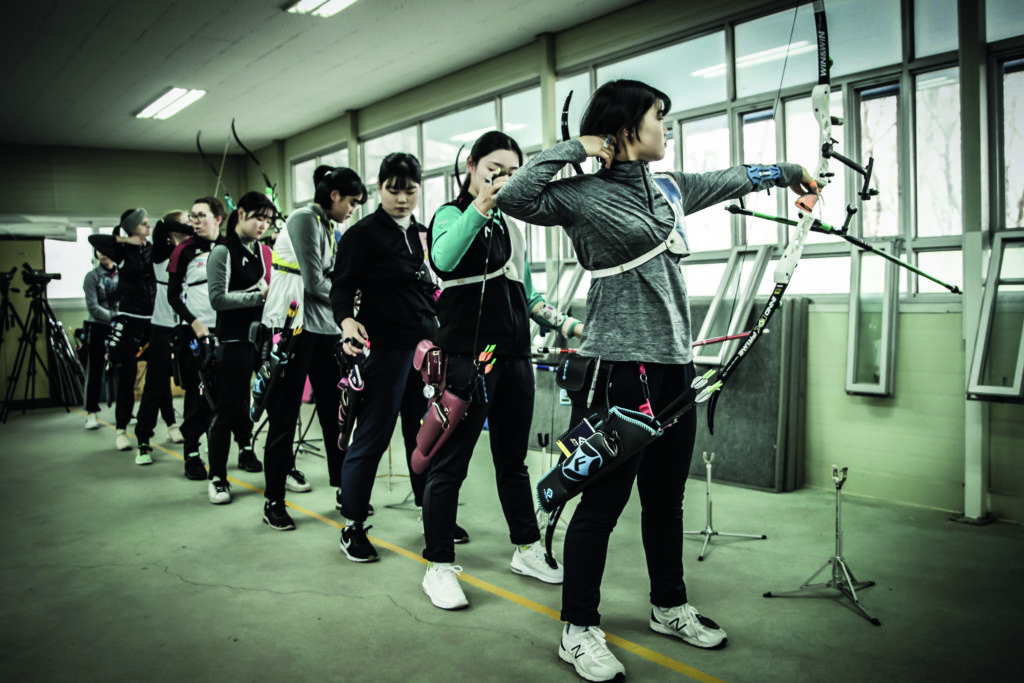
Kim Sam-soo, a coach and former director of the KAA, said in 2017: “Archery is a fierce competition for middle and high school athletes. If you are good for a year, you may be beaten by another player next year. There are some players who are student geniuses who have been on the national team pretty much since high school, and there are some players who don’t get much attention they become an adult like Park Sung Hyun or Ki Bo Bae.”
The best-of-the-best process, plus the astonishing training volumes combined with full-time, first-class coaching imbues Korean athletes with a deep confidence in their shot and a sense of superiority over opponents. They know how good they are, even if the nature of archery means they don’t always win. A truism in many walks of life is that you are ‘as good as’ your average performance, not your best one, and the system produces resilient athletes with consistence to their performance.
“The Olympic Games is easier than the national trials at home!”
The editor of Bow was lucky enough to be in the call room for the Rio Olympics just before the women’s team went on for their gold medal match against Russia. They were nervous, trying to laugh, keep each other smiling, but there was a sense of something nearly accomplished, something there for the taking. You sensed that they knew they only had to give an average performance, and it would be enough to take home gold – and it was.
THE TRIALS
Shortly before the final individual men’s matches in Rio, coach Park Chaesoon, known to international archery fans for his big grin, white hair, and loud encouragement, shouted at a nervous Ku Bonchan who had only just scraped through his last matches: “Do you have the confidence to win the Olympics? The Olympic Games is easier than the national trials at home!”
This year, Kim Sung-Hoon, general manager of the national team, said of the Korean national trials, “Only a player who shoots 100,000 arrows a year can become a national representative.”
That’s just a little under 2,000 arrows a week, every single week of the year. Only a tiny handful of international archers outside Korea train at anything like this volume. The truism that making the Korean national team is harder than winning the Olympics isn’t new. It may not be a fair comparison (and historical results don’t confirm it), but it is certain that the national trials are by far the toughest recurve tournament, or rather tournaments, in the world.

The Korea Archery Association has been using a system of multiple trials ever since it separated from the traditional archery association in 1983. The system was radically revised after the introduction of the head-to-head format at the 1992 Barcelona Olympics, which decreased the number of arrows shot in major tournaments. At that time, the archery team went through some ‘chaos’, relatively speaking – the results were still coming in, but the directors seriously thought that a subtle weakness was revealed – a lack of experience.
Teams from most other nations do not have such a wide base of athletes, so the players coming out to international competitions tend to be similar from year to year. These archers are accustomed to the world championships and the Olympics, however, the fierce competition at home means the team might change archers almost every year, with many athletes attending an international competition for the first time. With the general abandonment of the full FITA round internationally (although it remains the gold standard in Korea) the variance was deemed too high.
As director Jeong Young-sul said, “I decided to build a competitive and wide base so that the players trying out for the side could gain experience that was just as good as international competitions.” The number and duration of trials increased, and the qualification was focused on the ability to cope with environmental variables such as fitness, tournament ability, strong wind, leadership, and more. The goal was to find an all-rounder with the skills to cope with whatever might happen. As Oh Kyo-Moon says: “It tests everything. Everything.” In recent years, the formula has been changed slightly to add more weight to being able to perform in shootoffs, after the increasing number of high-profile tournaments decided that way.
‘Trials’ is an accurate definition: the entire process to make the national team for some athletes can take as long as seven months, with survival being the key element. Each selection tournament – there can be up to five – winnows down the field even further. If one tournament goes badly, that’s it. The toughest of all is the one in March which adds the best 24 from open trials to the 16 members of last year’s squad and, over a single brutal week, perms another 16 – eight men, eight women – from that 40, who will then go and train full time at the national centre in Jincheon with the national team coaches. (Indeed, elite archers may have a national coach, a pro team coach, and a personal coach, and you wonder how exactly they sort that out).

The lengthy process rewards stamina and consistency over flash-in-the-pan brilliance; watching the daily scores from the trials you often see younger athletes shoot to the top on the first couple of days, only to fall away towards the end of the week. Experience of the trials becomes an advantage in itself, which is perhaps why recent years have featured so many veterans. Kim Sun-woo, a high school student, caused a sensation by beating the world number one Kim Woojin in a shoot-off in a big money national tournament, but unlike Woojin, he wasn’t able to survive the trials and make the national side. Winners of major tournaments – which to the Koreans, means only the Olympics, the Asian Games, and the World Championships – get bonus points added to their trials scores as proven winners.
After the selection of a top eight each year, there is further selection to divide into A and B teams, with the top four athletes usually contesting World Cups and other major world events, and the bottom four getting the consolation prize of contesting the annual Asian Championships. Even so, only two individuals of each gender can go to the Asian Games individual finals and three to the Olympics. The ultimate decisions are made by the ominously-named Korea Archery Association Consolidation Committee.
The wide base and lack of sentimentality in the process has seen numerous occasions in recent years where world champions were not permitted to defend their titles because they did not make the final cut. At Mexico 2017, recurver Ki Bo Bae and compounder Kim Yun Hee were not sent to defend their 2015 world titles; the same happened to Im Dong Hyun and Song Yun Soo in 2019. The Korean media are just as surprised as the rest of the world not to see big established stars with proven winning ability performing again.
There are rules in place during the trials to prevent collusion, with all archers on the same team forced to compete in the same selection rounds. Nevertheless, questions have occasionally been raised about the transparency of the process; with the different interests and professional team sponsors who make up the executive committee of the KAA naturally wanting ‘their’ archers to make the national team. Ki Bo Bae and Chang Hyejin were even asked direct questions about selection transparency on live TV shortly after Rio 2016.
Needless to say, any manipulation is firmly denied; one of the executive directors, Jeong Young-sul, said, “I also would like a lot of our team members (Hyundai Steel) to participate and get through the trials. But if coaches start playing the rules in such a way, they would fail the whole Korean archery sphere.”
THE PRO TEAMS
You could easily say that the ‘real secret of Korean archery’ is ultimately not the trials, the training, the pro teams, the culture, or anything else. It’s the Korean tax system.
Many archery fans are familiar with the primary reason for Korean dominance at international level; a structure of funding that allows for around 130 full-time professional athletes to have just one job: shooting. This is achieved by having 50 or so professional teams sponsored either by private companies, local bodies, universities or the armed forces. However much coaching expertise flies around the world, this professional base is the ultimate weapon of Korean archery.
The ‘pro teams’ are hand-picked teams, rather than clubs, and a product of the school and university system. There is no amateur base or academy system. They are, instead, constructed as teams solely for competition. Essentially, they are part of the philanthropic department of the company or government body that sponsors them.
The central government mandates a certain amount of corporate philanthropic giving, reinforced with tax incentives. Sports teams are charity expenses. The same system funds several other Olympic sports, and baseball, a hugely popular sport in Korea. The biggest company of all, Samsung, funds teams in over a dozen different sports – although not an archery team. You could easily say that the ‘real secret of Korean archery’ is ultimately not the trials, the training, the pro teams, the culture, or anything else. It’s the Korean tax system.
While most other countries have a large amateur base and work towards elite performance, Korea is the opposite. It has an exceptional elite performance system, but almost no grassroots at all. It is almost impossible for members of the general public to access the sport (although a tiny handful of the traditional archery clubs also accommodate Olympic shooting). However there is a developing system of archery cafes, where the public can have a go. The largest one in Seoul is run by the Seoul Archery Association – a volunteer, amateur organisation.
In essence however the systematic, pragmatic, elite approach has many parallels in other Olympic sports programmes; e.g. track cycling in the UK: a well-funded, marginal-gains-obsessed, all-out attempt to win Olympic medals – which has also been highly successful for many years. UK track cycling and Korean archery share similarities in terms of public consciousness too. The Korean public is relatively unaware of archery apart from the big events every two years, when they naturally expect to see gold medals around necks – although its popularity as a TV sport is growing.
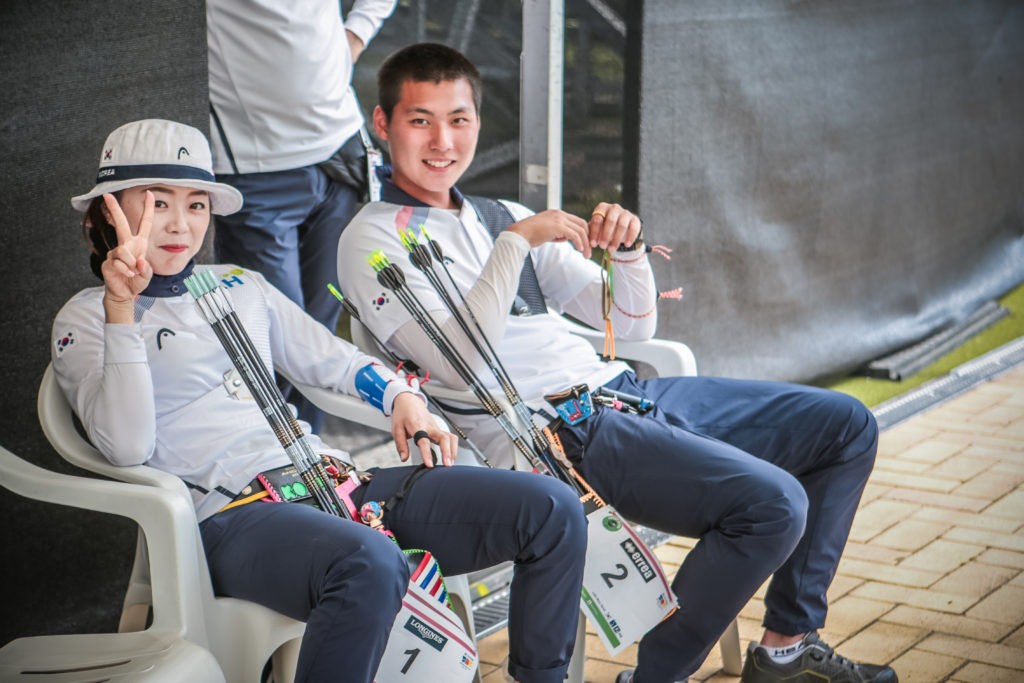
You will often see archery referred to as the Korean national sport, when it is anything but. Officially, the national sport is taekwondo, with millions taking part in some way. Ask a member of the archery elite in Korea how many athletes they have and they’ll reply in the low hundreds. They only consider the professionals.
A thought exercise, for those in the United Kingdom: imagine if, say, Richard Branson had pumped £10M a year into an Olympic sport – say badminton. He had then persuaded the CEOs at a few dozen other FTSE100 companies to each fund a team of badminton players, resulting in a deep pool of hundreds of pro athletes. And this had been going on for the last forty years, outspending every other country on the planet. Do you think Team GB would be taking home badminton gold medals at every Olympics?
THE MONEY
If you’ve read this far, you may not be surprised to learn that South Korea is probably the only country in the world where being an Olympic archer is a career that can make you at least reasonably rich.
Winning is good business for Korean archers. At the 2014 Asian Games in Incheon, Korean archers and coaches collectively received nearly 880 million won (over £500,000) in bonuses from their main sponsor Hyundai for the five golds, three silvers and one bronze medal they took home. The going rate for a gold medal then was 70 million won (about £41,000), with 60 million won for a silver and 50 for a bronze. Not bad, and apparently more than the Korean government bonus for Olympic gold medals in 2012. Hyundai handed out similar bonuses to the medallists after London and Rio, and the 2018 Asian Games – and the prize money is not going to be going down.
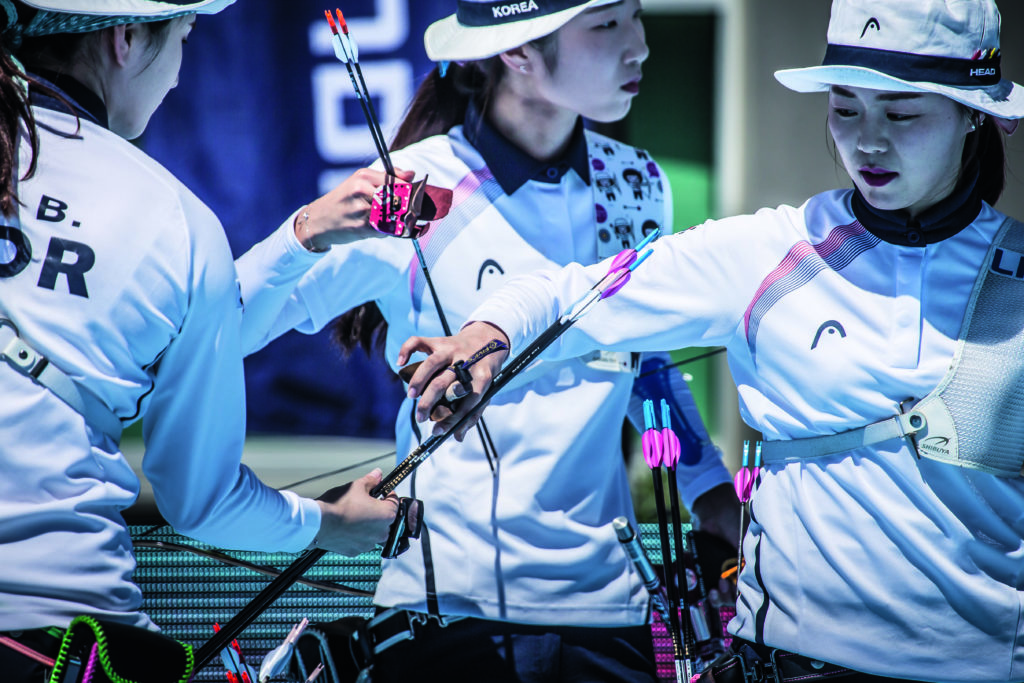
Many nations dole out central government cash for Olympic success. The top payer used to be Singapore, offering a million Singaporean dollars – a little over half a million pounds – to any of their sportsmen who took home an Olympic gold medal. (This longstanding prize was finally claimed for the first time by swimmer Joseph Schooling in Rio.) Now, Malaysia is the top payer, offering a million US dollars for Olympic gold. The rate tends to be higher for non-G20 countries. Great Britain, notoriously, gives nothing, and was in fact the only country at Rio 2016 not to offer a monetary bonus for winning medals.
But in Korea, winning Olympic gold gets you a monthly stipend for life. These pensions were originally cumulative, allegedly until Kim Soo-Nyung, the greatest Korean Olympic archer of all, won three gold medals, and they realised she might eventually bankrupt the Olympic funds. Pensions became a capped event – and supposedly, the rule was changed specifically because of her. Nevertheless, it remains a big financial carrot for Olympic athletes to continue working at their careers.
While the stars make a serious living with bonuses and government cash, on the bottom rung professional archery isn’t a big money spinner. The starting salary of a company team pro is around £14k a year, although you usually get somewhere to live, and sometimes a car, too. Like most sports teams, the big names will be on considerably more, and there’s even more money if you make the national side. (The salaries of the national team members are still paid by the company teams, even if they aren’t always available to compete for that team.) The best-known Olympic medallists have been tapped to advertise products too.
For the national governing body, around half of the $11M a year operating budget ultimately comes from Hyundai and its subsidiaries. The historical reason for this is that in the early 1980s the government leaned on their big corporations to fund Olympic sports – specifically, less popular sports – by giving them tax breaks to do so. At this time South Korea was transitioning from a military dictatorship to a modern democracy, given full flower in the Seoul Olympic Games of 1988.
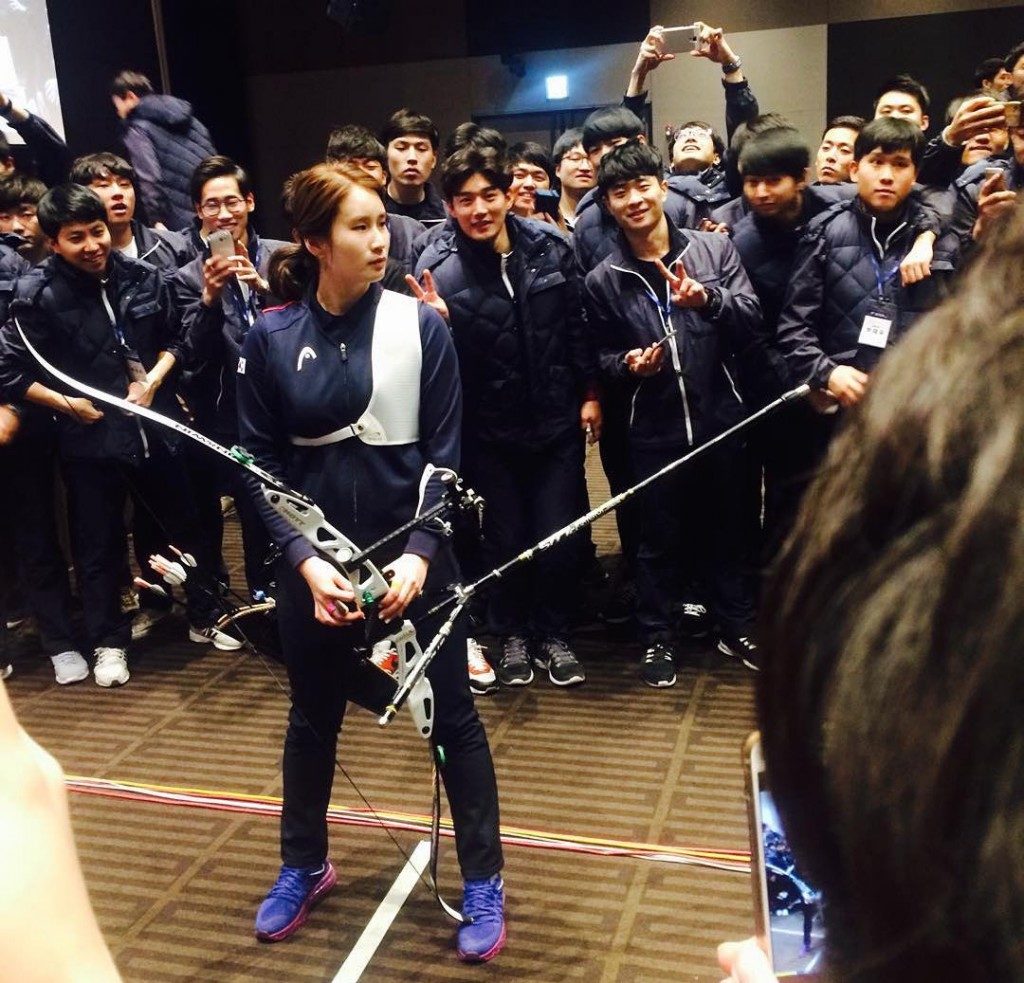
A well-funded archery machine was soon in place. The governments changed, but over time the corporations came to see funding Olympic sports as both an excellent marketing opportunity and a useful, very public exercise in social responsibility – as well as a way of completing their mandated philanthropic duties. The success of Korean archery and the success of Hyundai and Kia Motors reflect each other; a win-win situation.
The KAA and its sponsor remain deeply entwined today, as was seen at the 2014 Asian Games on home turf in Incheon. The KAA’s formidable patron and chairman at the time, Chung Eui-Sun – then vice-chairman of Hyundai – took the extraordinary step of rebuilding sections of the archery field after complaints were raised by the attending media. It was an insight into quite how powerful the chaebol corporations are.
THE FACILITIES
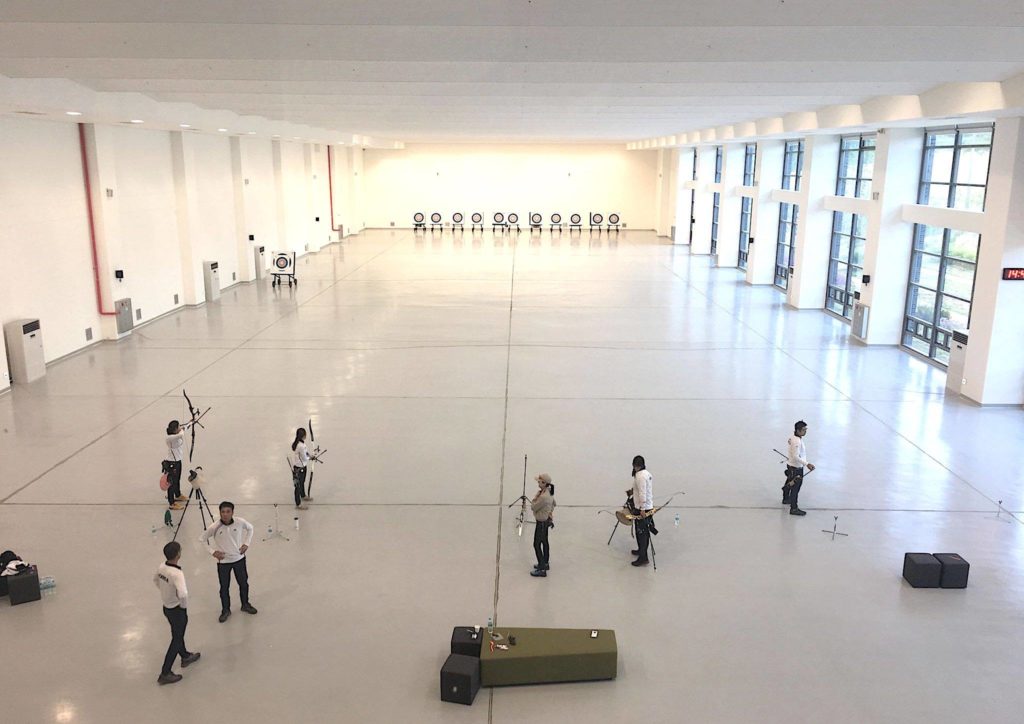
After South Korea was awarded the 2018 Winter Olympics, there was a large reorganisation of Olympic sport and the training centre for national archery team athletes moved from Taerung on the outskirts of Seoul to a huge multi-sport complex in Jincheon, about 70km southeast of the capital.
As one of the biggest Olympic medal ‘bankers’, the archery team got the very best facilities available, including a 90m indoor range (hidden underneath a 90m outdoor range) that looks like something out of a science-fiction movie, built solely for the eight people on the frontline national team each year. They don’t even have to share a field with the compound team, who have their own, completely separate facilities at the same centre.
As long as Korean archers keep bringing home international gold medals, it appears that no expense will be spared to maintain the very best of the best. Unlike every other team, who have to wait for the bus at international events, they often have their own transport – usually supplied by the local Hyundai dealership.
But the extreme lengths that the KAA will go to to protect their investment is best illustrated by what happened at Rio 2016. Arriving to inspect the facilities a couple of years prior to the Games, officials realised there was nowhere to house the athletes near the Sambadromo, and nowhere for the athletes to relax. The test event saw the teams struggling with the food and the humidity.
They eventually hatched an extraordinary plan. While the athletes would stay in the Olympic village, the KAA rented an empty garage near the venue, and installed a high-end air-conditioned camper van for the athletes complete with beds, sofas, TV’s, a kitchen and a fully stocked fridge with Korean food and snacks. It was used as a base just a few hundred yards from the venue. (The editor has seen photos of all of this, but unfortunately, he cannot share them with you. You’ll just have to take our word for it.)
The entire operation cost tens of thousands of dollars. When word got out among the national Olympic camp, the garage briefly became rather popular with various travelling Korean officials, who had to be gently moved on when the archery competition started. And while other teams had to sit on a plastic chair in a field, just six of the 128 athletes had the very best of everything.
Thanks to the many Bow writers, archers, coaches and others who contributed to this piece.


Am a South African recurve bow archer, kindly advise on how one may come to Archery schools / training camps in Korea?
Please furnish information on Fees, accomodation & meals
I’m looking for the best trainer in Korea to get a job abroad for 4 years